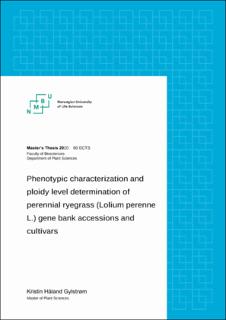| dc.contributor.advisor | Rognli, Odd Arne | |
| dc.contributor.author | Gylstrøm, Kristin Håland | |
| dc.date.accessioned | 2020-10-14T09:09:41Z | |
| dc.date.available | 2020-10-14T09:09:41Z | |
| dc.date.issued | 2020 | |
| dc.identifier.uri | https://hdl.handle.net/11250/2682676 | |
| dc.description.abstract | Perennial ryegrass (Lolium perenne L.) is the most grown perennial grass species all over the world, because of the rapid regrowth and good nutritional composition. Winter survival is challenging when growing perennial ryegrass in the northern and eastern parts of the Nordic/Baltic region. Several Nordic and Baltic universities and breeding companies are collaborating in a pre-breeding project for perennial ryegrass, to develop germplasm that can meet the coming climate changes and increase utilization of perennial ryegrass in this region.
The benefits of pre-breeding are the possibility to increase the genetic variation by intercrossing of diverse genetic material. Phenotypical studies of single plants are common for obtaining knowledge about the variation of the material before making crosses. In this study, we investigated 389 populations of perennial ryegrass from different places in Europe, consisting of both collected material from gene banks, landraces, breeding lines and cultivars. The populations were phenotyped in four single plants experiments in different Nordic locations for the traits winter survival, resistance to crown rust, plant height, heading date and regrowth after 1st cut.
Flow cytometry was used to determine ploidy for all populations. This resulted in 306 diploid, 76 tetraploid and 5 populations which were mixtures of diploids and tetraploids. This information is crucial for utilization of genotypes in further crosses since diploid and tetraploid plants must be crossed separately. The study also deals with comparisons of populations with different ploidy and accession types for these traits.
Passport data for 64 populations were improved by converting collection site to coordinates including altitude for 54 populations. Information about ploidy are important for updating the passport information. Nineteen of the populations had a different ploidy level compared to the origin specified in the passport from the gene banks.
Winter survival is essential for growing perennials. By investigating G x E interactions for different years and locations, winter survival of tetraploid Baltic breeding lines and diploid ecotypes from Eastern Europe were identified as phenotypically stable with god winter survival. Tetraploid populations may appear to have a better de-hardening and re-hardening capacity with fluctuating temperatures during the winter. | en_US |
| dc.description.abstract | Flerårig raigras (Lolium perenne L.) er velkjent for rask vekst og god fôrkvalitet, og er den mest dyrkede flerårige grasarten i verden. Ved dyrking av flerårig raigras i nordlige strøk er vinterherdighet en utfordring. Nordiske og baltiske universiteter og foredlingsbedrifter har gått sammen om et «pre-breedingprosjekt» i flerårig raigras for å forbedre de egenskapene som trengs for å møte kommende endringer i klimaet og økt dyrking av raigras i denne regionen. Fordelen ved «pre-breeding» er muligheten til å utvide den genetiske variasjonen ved samkrysning av genetisk materiale med høy diversitet. For å vite noe om variasjonen i materialet før en samkryssning, er det vanlig å studere enkelplanter av ulike populasjoner i forsøk. I denne studien er det sett på 389 populasjoner av flerårig raigras fra ulike steder i Europa bestående av innsamlet materiale, landraser, foredlingslinjer og markedssorter. Populasjonene ble fenotypet i fire enkeltplante-forsøk ved ulike lokasjoner i Norden for egenskapene vinteroverlevelse, rustresistens, høyde, skytetidspunkt og gjenvekst etter første slått. | en_US |
| dc.language.iso | eng | en_US |
| dc.publisher | Norwegian University of Life Sciences, Ås | en_US |
| dc.rights | Attribution-NonCommercial-NoDerivatives 4.0 Internasjonal | * |
| dc.rights.uri | http://creativecommons.org/licenses/by-nc-nd/4.0/deed.no | * |
| dc.subject | Perennial ryegrass | en_US |
| dc.subject | Diploid | en_US |
| dc.subject | Tetraploid | en_US |
| dc.subject | Ecotype | en_US |
| dc.subject | Cultivar | en_US |
| dc.title | Phenotypic characterization and ploidy level determination of perennial ryegrass (Lolium perenne L.) gene bank accessions and cultivars | en_US |
| dc.type | Master thesis | en_US |
| dc.description.version | submittedVersion | en_US |
| dc.subject.nsi | VDP::Matematikk og Naturvitenskap: 400 | en_US |
| dc.source.pagenumber | 145 | en_US |
| dc.description.localcode | M-PV | en_US |

